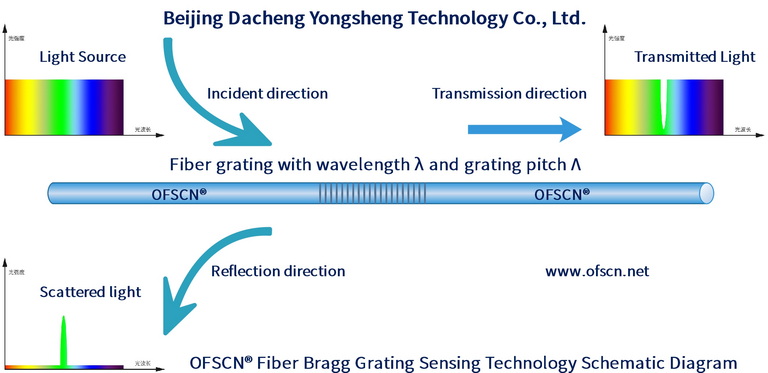Fiber Bragg Grating Sensing Technology Encyclopedia - FBG FAQ - FBG Sensor FAQ - FBG Demodulator FAQ - FBG Common Application Problem Analysis
Basic Principles of Fiber Bragg Gratings and Fiber Bragg Grating Sensors - Part 2: FBG Sensing Principles
This article explains the basic principles of FBG based on actual optical waves. It helps readers understand the underlying mechanisms of FBG sensors, FBG strain sensors, and FBG temperature sensors. This article serves as a preliminary introduction to the OFSCN® capillary seamless steel tube FBG sensors produced by DCYS.
In the previous article, "Basic Principles of Fiber Bragg Gratings and Fiber Bragg Grating Sensors - Part 1: Reflection and Interference of Waves," we used sound waves as an analogy to understand the principles of OFSCN® capillary seamless steel tube FBG sensors, specifically the reflection and interference (interference) of waves.
Today, based on that foundation, we will introduce the basic principles of FBG sensors (including FBG principles). This article is also a popular science article and not a research article. If anyone finds any errors in this article, please kindly point them out.
 |
| Image 1 |
1. Fiber Bragg Grating (FBG) in Fiber Bragg Grating Sensor (FBG Sensor)
The FBG Sensor is a type of optical fiber sensor. The sensing process is based on the modulation of the wavelength of the FBG by external physical parameters to obtain sensing information. It is a wavelength modulation optical fiber sensor.
The image above shows a schematic diagram of a optical fiber core with a FBG (actual diameter of 9 micrometers). By using methods such as UV light exposure through a photomask, femtosecond laser point-by-point inscription, or other processing techniques, numerous weak reflection surfaces (we will not discuss more complex gratings here) with the same spacing are formed in the optical fiber core. These weak reflection surfaces are called optical fiber gratings, and the distance between each weak reflection surface is referred to as the grating pitch or grating period (represented by the symbol Λ - please remember this symbol, as it will be used in the following text).
 |
2. Sensing Principles of FBG and FBG Sensor
Basic sensing measurements can be performed using the FBG mentioned above. The principle is shown in Image 3.
 |
3. Fomula of FBG and FBG Sensor Principle
The middle section of Image 3 represents a FBG or an encapsulated OFSCN® capillary seamless steel tube FBG Sensor. Broadband incident light enters the FBG sensor from one end of the grating. When the light encounters the FBG, most wavelengths of light pass through the FBG as transmitted light, while a small portion of specific wavelengths of light are reflected back (please note these specific wavelengths, which are the object of our detection and are represented by λB). There is a direct relationship between λB and the grating pitch (grating period) Λ we mentioned earlier, expressed by the mathematical formula: λB = 2neffΛ, where λ represents the reflected wavelength, neff is the refractive index of the optical fiber core, and Λ is the grating pitch (grating period).
The reflected light then enters the FBG demodulator (not labeled in the diagram) and is demodulated into a wavelength signal λB. Since the FBG sensor is connected to the FBG sensing device, we can obtain a different test wavelength signal λB at each moment. From the previous mathematical expression, we can understand why the wavelength signal λ returned in the next moment changes (represented by ΔλB). The fundamental reason is that the grating pitch (grating period) Λ of the fiber optic grating has changed (represented by ΔΛ).
4. Principles of FBG and FBG Sensor for Temperature, Strain, and Stress Measurement
Now, let's step away from complex mathematical symbols and imagine real-world scenarios. What can cause a change in the grating pitch (grating period) Λ?
You might have already guessed the first possible reason: force. When you apply tension to the FBG, it elongates, and when you apply compression, it contracts.
The second possible reason is temperature. The FBG expands when heated, causing it to elongate, and contracts when cooled, causing it to shrink.
During this process, clever individuals have associated the accurately detectable wavelength signals with three basic physical parameters: force (tension, compression), length (elongation, contraction), and temperature (heating, cooling). Therefore, the basic physical quantities that FBG Sensors can directly measure include stress, strain, and temperature (corresponding to OFSCN® capillary seamless steel tube FBG stress sensors, OFSCN® capillary seamless steel tube FBG strain sensors, and OFSCN® capillary seamless steel tube FBG temperature sensors, respectively).
 |
|
图4 |
As an introductory article about the OFSCN® capillary seamless steel tube series FBG sensor, we have simplified the mathematical calculations and considered the wavelength changes caused by stress, strain, and temperature. The mathematical calculation process for wavelength changes is more complex than the simple equation "λB = 2neffΛ" we presented earlier. This complexity arises because the refractive index neff of the fiber optic core is also a variable. The overall formula is as follows: ΔλB = λB(1 - Pe)Δε + λB(αf - ξ)ΔT, but we will not delve into it here.
By this point, you may have gained a certain understanding of the working principles of FBGs and FBG sensors. Then, what other challenges exist in the transition from the theoretical FBG to practical encapsulated FBG Sensors? How can these challenges be addressed? We will discuss these in the following sections, so stay tuned!
Our philosophy is: "OFSCN®, make optical fiber stronger!"
Attachment 1:
Related video introduction:
DCYS is a professional fiber bragg grating sensor manufacturer, providing the principle of FBG, FBG sensor temperature measurement principle, stress measurement principle, strain principle, temperature compensation principle and seamless steel tube packaging principle; the brand of FBG sensor is "OFSCN ".
